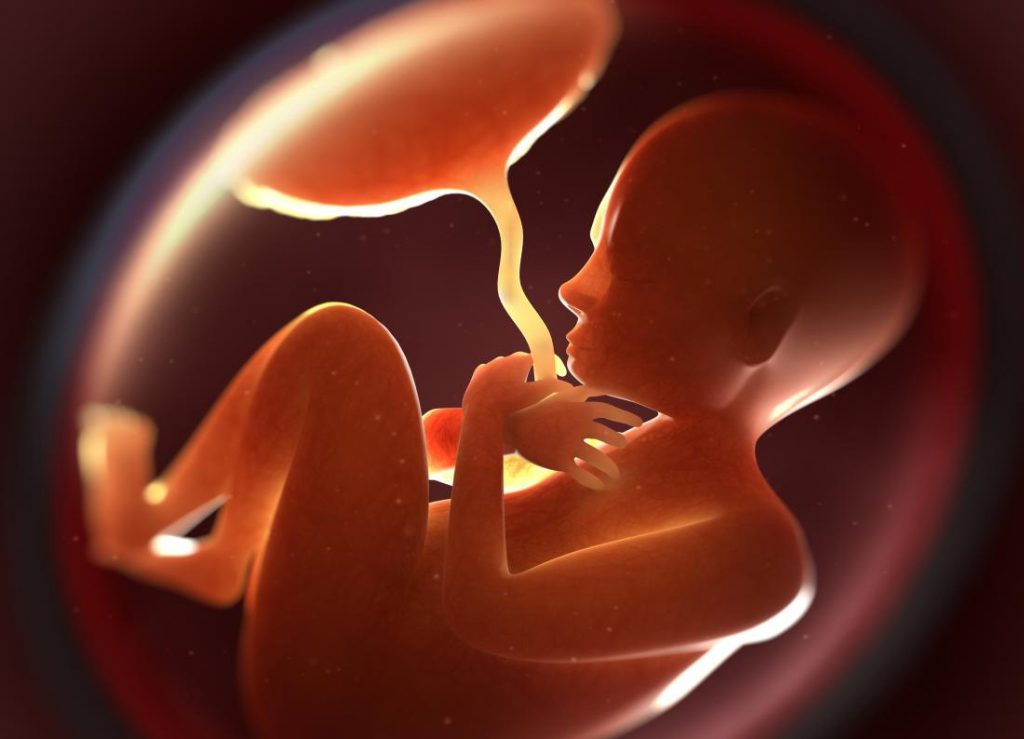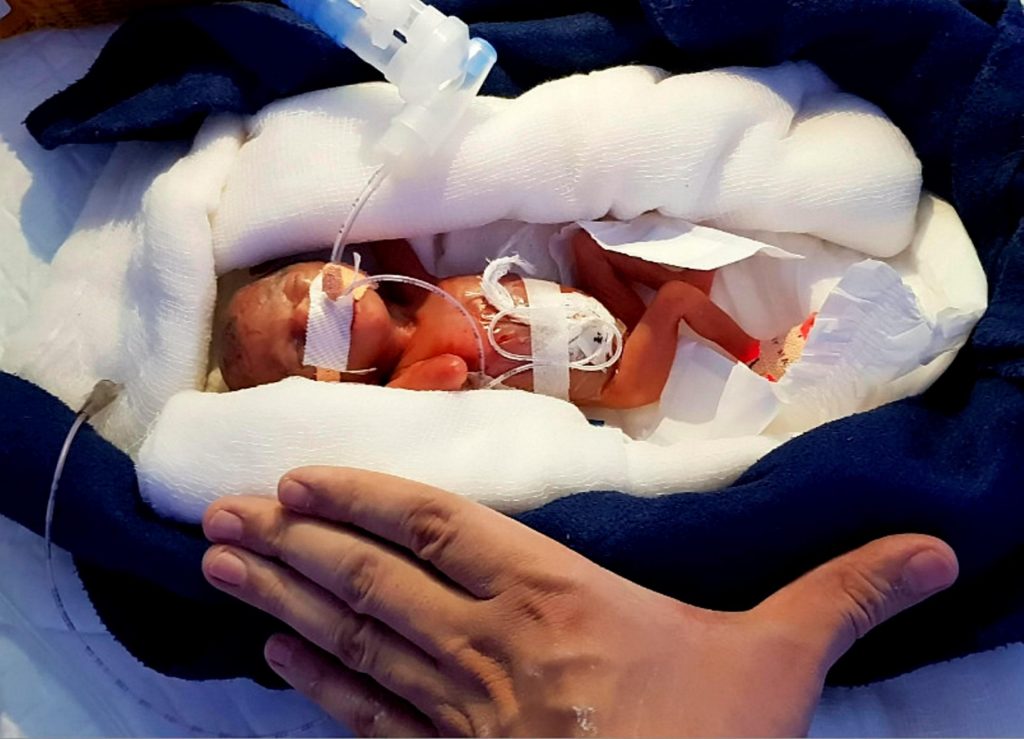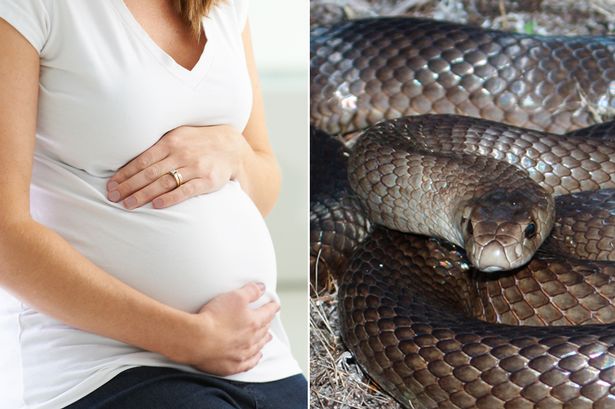
Angie Realizing She Had Been Bitten By A Snake
Immediately upon stepping down, Angie felt a sharp, stabbing pain on the pinkie toe. She glanced down, which wasn’t easy with her large tummy and realized the horror of her current situation. Angie had just been bitten by a snake! When she ran inside her home, she screamed her husband’s name, Colby. He was in shock when she told him what had happened, and had to make a quick decision which could haunt him forever.

Snake Taking a Bite
Angie’s husband was quite worried about the snake. What if it was venomous? He immediately rushed out to the outside of the home, but he couldn’t see a snake. It apparently had vanished beneath the deck. Colby could have tried to go searching for it so that the right anti-venom was given, but he knew that his wife needed to get to a hospital. Her husband was pretty sure it was a copperhead snake, so he chose to focus on his spouse.

Photo Of A Deck On A House
The couple immediately drove to the nearest hospital, which was over an hour away. However, Angie’s foot was already swelling, and she was in extreme pain. While the clock ticked away, her husband sped faster to the hospital. Both of them immediately realized that they didn’t have a clue as to what to do. She was so worried, but it wasn’t for her leg. Primarily, she feared for her unborn baby and whether or not the venom was poisonous.

Angie’s Foot Swelling Up
Because she didn’t know much about the snake or what to do for a bite, she called the doctors at the hospital. They advised her to keep her leg down instead of raising it up. Generally, when a person suffers from swelling, it’s best to raise that part of the body above the heart to help. However, this would have caused the venom to travel upwards in the body and toward the heart!

Picture Of A Poisonous Copperhead
The moment the couple got to the hospital, doctors and nurses were there to get her into an examination room and take care of the situation. However, the doctors claimed they had never even seen a pregnant woman who had been bitten by a snake before! Even these trained professionals didn’t know exactly what to do. Usually, anti-venom is administered as a shot, but they worried about giving this life-saving medicine to Angie. Find out why below!

Doctors And Nurses In A Rush
In most cases, a snake bite isn’t a big deal. Of course, the victim has to get to the hospital in time for the anti-venom dosage, but they are usually fine. A night of observation is often all that’s needed, and the person can go back home. However, in Angie’s case, the dose of anti-venom might have been too strong for her baby’s heart to handle. Read on to see what she chose to do!

A Baby With A Large Snake
Angie didn’t have a lot of time to think, but she knew that her decision could have negative consequences for her and/or her baby. Plus, there was her dear husband, Colby, to consider, as well. She could take the dose of anti-venom, which could harm her unborn baby, or the doctors could deliver the baby with an emergency C-section four full weeks early. After the baby was born, she could take the anti-venom and save herself, too.

Angie During Her Dilemma
No one could know what they’d do in a situation like that, but Angie never even faltered. She chose to risk her own life for that of her unborn baby. Immediately, she told the doctors to get ready for the emergency C-section. Her husband, though worried, was in complete agreement with his wife. They tried to prepare themselves mentally for what was in store, but that was impossible because they’d never experienced it before.

Pregnant Woman’s Belly Next To A Snake
Though Angie and Colby wanted the baby out of the womb so he would be safe, the doctors were more focused on whether or not their child could live outside his mother. For one, he would be one month early, and his lungs might not be fully developed. He’d have to be on a breathing machine, and no one could predict how long that would be. That wasn’t the only problem to consider!

Baby On A Ventilator
Having an emergency C-section wouldn’t just adversely affect her baby. Because it was a surgical procedure, there would be some blood loss. This is normal, but Angie was also dealing with the venom in her foot, which had traveled to her leg. The excess blood flow could also increase the flow of venom throughout her body. With the poison moving quickly throughout the limbs, it might reach her heart faster, inevitably killing her.

Doctor Marking The Spread Of The Venom
The doctors prepared a room and got Angie prepped to surgically remove her son from the womb. Within less than an hour, baby Corbin was delivered using a Caesarian section. Once Angie was sure her baby was safe in the doctor’s arms, she allowed them to administer the anti-venom to save her life. Luckily, the doctors moved swiftly enough that her act of heroism saved two lives that day.

Doctors Preparing For A C Section
Of course, that wasn’t the end of the trauma for the family. Corbin was born alive, but he had a few issues. Primarily, this little bundle of joy was born four weeks too early, which means his body wasn’t quite capable of living outside the womb. For another, the poison working through his mother’s body affected him somewhat. Baby Corbin had to be on a ventilator for a few days, but he was finally healthy enough to go home.

Baby Born At 36 Weeks
Though the doctors in her hometown weren’t sure what to do for a pregnant woman bitten by a poisonous snake, that doesn’t mean it never happens. While rare, another woman faced a similar issue after she was bit by a snake at a swimming spot by a water moccasin. Kingsland, TX is well-known for its walking trails around The Slab, and Kamri Thompson has walked it about a hundred times, according to her.

Kamri Thompson With Her Daughter
The Slab has always given Kamri so much peace, and she chose to spend most of the summer there while pregnant. However, on a Sunday in September, she received a terrifying jolt of reality. She did watch where she walked, but Kamri didn’t immediately notice what she stepped on and thought it was just an ordinary stick. Nothing caught her eye or made her think something was wrong. It almost felt like a needle prick.

The Slab
When she felt the pain, she did glance down to see what happened, thinking she’d see nothing because she’d already left the stick behind. However, what Kamri saw shook her to the core. This pregnant woman saw a Water Moccasin on her foot. One of its fangs had sunk itself into her sandal, but the other one was right in her foot. She immediately knew that it wasn’t a good situation, but she had no idea that what happened next was possible!

Water Moccasin Biting A Boot
Though her dad wasn’t excessively worried, he called 911, and Kamri was immediately rushed to the hospital. Her father, Ben Thompson, followed behind. At first, he thought everything was going to be fine. They’d likely give her some anti-venom and observe her for a few hours or overnight. He’d been to The Slab for the last 20+ summers and had never had an issue with a Water Moccasin; they’re around, but they usually stay away from people!

Water Moccasin
With her father hopeful and Kamri trying to think positively, the doctors had something else in store for them. Usually, it is as easy as administering anti-venom, but everyone had forgotten one little detail: Kamri was pregnant! Anti-venom isn’t an option for pregnant women because these and other medicines aren’t tolerated very well. Her tiny, unborn baby wouldn’t be able to handle such strong medication, and the means of providing it were just too horrible to think about.

Picture Of Syringe
Though Kamri was bitten on the foot, the anti-venom had to be administered in a specific location. It just so happened that the needle might have to penetrate the placenta to provide its life-saving functions. While the anti-venom could possibly have been given at a different site, the medicine had to flow throughout the body, which would have given a double dose to the little baby in Kamri’s womb.

Placenta In A Pregnant Woman’s Body
Sometimes, there are alternative methods that can be used. Dr. Sheila Parech was the OBGYN at the hospital where Kamri was taken. Often, it’s a different kind of medicine that is considered safer to the mother and unborn baby. Other treatments can also be provided in most cases. The problem here was that there were no other medicines or treatments. In fact, the only way to save Kamri’s life was to take the anti-venom and risk harm to her baby.

Snake Spraying Its Venom
Kamri and her family faced a very tough decision, and neither of the choices was all that great. She could decide to have her baby delivered three full months early, or treat her symptoms and pray that the venom didn’t spread throughout her body or reach her unborn baby. Neither option was altogether ideal, but she had to make the right one for herself and her little one. Therefore, she chose to protect her baby the only way she knew how: With prayer.

Pregnant Woman’s Belly
Premature birth is always a risk, but when the baby is a full three months early, it’s almost impossible to consider. For one, their lungs and other organs aren’t fully developed. They can’t breathe on their own and require a ventilator. However, that’s not all. Babies who are born too early can also have problems with temperature control where they don’t sweat to relieve heat. Other issues can include heart, brain, and gastrointestinal issues. With all that, Kamri couldn’t bear to deliver early.

Baby Born 3 Months Early
She chose to wait it out, praying with all her might that the venom would stop spreading. Kamri gathered together her whole support group, and they all prayed. Her promise to God was that if the poison were ‘sucked out,’ she’d tell everyone it was His doing. Within a few agonizing hours, her treatment and prayers worked. The venom spread no further, though it wasn’t altogether out of her body.

Pregnant Woman Touching Her Stomach
Since the venom stopped spreading throughout her body, she was able to go back home and enjoy the rest of her pregnancy. Of course, she was much more careful and steered clear of The Slab. She said that once she gives birth, she plans to take her baby there along with its grandfather. While she’ll be excessively nervous, the place has always brought joy and peace to her and her family.

Kamri Thompson’s Swollen Foot
Though Kamri and Angie both survived the snake bite, as did their unborn children, that wasn’t the case for another woman from Meekatharra, Australia, which is about 771km northeast of Perth. Sanita Martin was only 31 weeks pregnant. She was in her backyard when she was bitten by a snake. On a Monday night, Martin thought she’d sit outside and enjoy the sounds. However, she wasn’t prepared for the snake that bit her.

Sanita Martin
Sanita Martin was instantly terrified about what it would do to her and her unborn baby. However, she almost immediately felt woozy from the snake bite. Still, the 27-year-old woman was able to call a relative for help before having seizures. An ambulance from St. John arrived at her home at about 8:45 p.m. Though first responders were prompt, Martin had already gone into cardiac arrest by the time they got there. Find out what happened next!

Australian Ambulance
As soon as the paramedics arrived on the scene, they knew that Ms. Martin was in significant danger. They weren’t sure what the problem was, but they performed CPR on her to try to help her breathe and keep her body alive. She was rushed to the Meekatharra Hospital. At this time, she was already unconscious, so she couldn’t tell the paramedics what had happened to her. Even if she’d been able to voice the cause, it might not have helped.

Pregnant Woman In Cardiac Arrest
Poor Sanita Martin was so young and vibrant. She had her whole life ahead of her and was expecting her second child. Her handsome 3-year-old son was an excitable young man who was excited to have a new baby brother or sister. They had both moved to Meekatharra recently so that they could be closer to their relatives. At the time of her death, Martin was living with her mom, who wasn’t home at the time.

Sanita Martin Selfie
Sanita Martin was unable to be saved, and she was pronounced dead at the hospital. Unfortunately, so was her baby. Though all efforts were made to save the baby, it expired shortly after its mother. At just 31-weeks along, the unborn baby did not have a very high chance of success at life. Martin’s orphaned son is now living with his grandmother, Sanita’s mom. Read on to find out why pregnant women should be extremely cautious about snake bites.

How A Baby Would Look Born At 31 Weeks Old
Dr. Timothy Jackson is a toxicologist at the Australian Venom Research Center. He claims that Martin’s pregnancy hastened her death because of low blood pressure. Supine hypotension is associated with pregnancy. When she was bitten by the snake, it likely caused her quick collapse. Snake bites can cause significant fluctuations with blood pressure, leading to rapid deaths. It happens so often that it’s called “Rapid Collapse” in Australia.

Dr. Timothy Jackson
Dr. Jackson focuses primarily on venomous snakes and knows that rapid collapse is primarily connected with a few species. Because of this, people might collapse within just half an hour or an hour after a bite. The western brown snake was the likely culprit for poor Martin. These snakes are the cause of over 60 percent of all life-threatening snake bites in West Australia. Of course, there is another species that could be to blame.

The Western Brown Snake, Which Is Deadly
Corin Desmond is a reptile enthusiast with many years of experience when it comes to snake bites. He also believes that the western brown snake could have been the culprit. It’s highly dangerous to people in vulnerable situations, such as 31-weeks-pregnant Martin. However, another species could be to blame: The desert death adder. These snakes can strike when they are surprised and are highly deadly. Find out the difference between the two below.

Death Adder
Neither the enthusiast nor the toxicologist can know for sure because either snake could have been the one that bit Sanita Martin. Usually, the western brown is more aggressive than other venomous snakes in the area, including the death adder. Generally, the death adder is rarer in the area, so they are scared and avoid humans whenever possible. Plus, western browns are more likely to go after someone than the death adder. Still, it has a higher mortality rate when the victim doesn’t get anti-venom in time.

Deadly Death Adder
Dr. Jackson claims that the treatment window for snake bites can vary based on a variety of factors. For one, the species of snake makes a great difference. Of course, it also depends on how much venom it injects into the victim, the person’s physiological state, and much more. In his opinion, remoteness was Sanita Martin’s biggest danger. Since she didn’t call emergency response services first, her family had to do it for her. This took longer for paramedics to arrive.

Map Showing Meekatharra
In the US, hospitals are well-equipped with anti-venom of the most popular snakes in the area. However, locations outside the United States may not have the budget to keep medicine in stock. Plus, they may see few, if any, snake bites. It’s not that there aren’t a lot of snakes there; in fact, there are millions. However, there aren’t very many people around to get bitten. What happens because of that?

Vintage Syringe And Bottle Of Antivenom
Sanita Martin lived in a remote area, first responders weren’t called immediately, and she was pregnant. All of these factors could have caused her demise and that of her unborn baby. Even if she had made it to the hospital in time, a bite from the death adder or the western brown was still likely to be fatal – for one or the other. The dosage needed to prevent the toxins from reaching her heart would have killed her unborn baby.

Death Adder Anti Venom
With the other moms-to-be – Angie and Kamri – the snakes weren’t as poisonous. Whether divine intervention occurred or not, their bodies were strong enough to fend off the toxins. For Angie’s case, she chose an emergency C-section to try to save her baby. In just enough time to spare, she received the anti-venom, saving her life. Kamri chose to rely on God and various treatments to stop the spread of the venom, saving her unborn baby.

Snake Biting A Hand
Though Kamri and Angie were both bitten by venomous snakes, their situations were quite different. They were both with family members at the time and were both rushed to the hospital. In Angie’s case, it took about an hour, but the snake that bit her had slow-acting venom. Plus, it’s unknown how much venom was coursing through her body. Sanita had none of those things going for her, as she was alone and didn’t call emergency services herself.

Pregnant Woman Alone In A Field
It’s unknown how long Sanita was in her mother’s home after the snake bit her. No one knows how long the first responders took to get on the scene. Though CPR was provided, Martin had already been convulsing and in cardiac arrest when paramedics arrived. Inevitably, her death also caused the death of her unborn baby, and her 3-year-old son is now an orphan. Her story stands as a warning to pregnant women everywhere, so her death wasn’t in vain.

Sanita Martin With Her 3 Year Old Son
Though it seems over-the-top, pregnant women should consider where they live and be mindful of where they go and step. It’s ideal to stay in public places and not be in the wilderness. That way, if you do get bitten by a snake, you’re near to a hospital. You may also want to talk to the local hospital staff to find out if they have anti-venom for all types of snakes in the area.

Pregnant Woman And Snake







